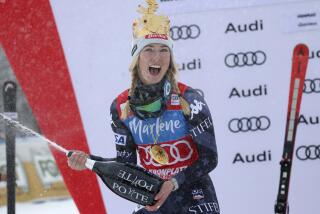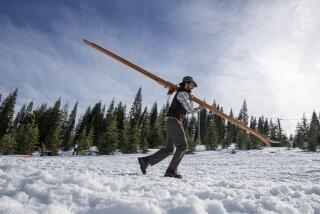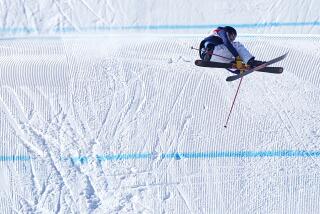They’re Winning an Uphill Battle : Skiing: Phil and Steve Mahre were enjoying retirement after their Olympic successes in 1984. Now they’re back battling slopes on the pro circuit.
- Share via
Phil Mahre won gold and silver medals in the Winter Olympics. He was the World Cup champion for three consecutive years. He’s now 32.
So what is America’s greatest skier doing, still out there racing against a bunch of Swedes and Austrians and others on the U.S. Pro Tour, most of whom wouldn’t have been allowed on the same hill with him at Lake Placid or Sarajevo?
After all, his archrival back in the early 1980s, Ingemar Stenmark, has retired to his villa in Monaco. A ski racing champion is supposed to be set for life. At least, that’s what Bill Johnson thought when he was asked in 1984 what winning the downhill gold medal meant to him. “Millions,” he shouted.
But as Johnson has since learned, that’s only in Europe.
Even though he was the first American male to win Olympic gold in Alpine skiing, beating Mahre for that honor by just a couple of days, Johnson did not come close to making the Fortune 500. He did acquire a fancy sports car and a house in Malibu, briefly, but that’s another story.
Phil Mahre and his twin brother, Steve, came home from the ’84 Games to diapers that needed changing and families that needed supporting. They went out on top, then set themselves up in business. But, as with Johnson, the millions just weren’t there--not that they really had expected them to be.
During the next four years, the Mahres started a line of ski clothing and established their own training centers for recreational skiers, while continuing longtime associations with various companies in the ski industry. They did just about everything except race.
There was talk in 1986 of their making a comeback with the U.S. ski team, but nothing developed.
“What happened,” Phil said the other day, “was that they approached us in the spring of ’86 and asked if we would be interested in rejoining the team for two years, through the 1988 Winter Olympics at Calgary.
“We told them what we’d need, what the figures had to be, for us to return. The ball was in their court, but we never heard anything back. There were so many questions to be answered: Would we have to give up the clothing line? The training centers? And so on.
“But I think we could have won some races again.”
The clothing line is no more, and although the training-center programs have been successful, the Mahres clearly figured they could use the renewed exposure--as well as the money--when they decided to come out of retirement and join the pro circuit last winter.
Phil almost won the championship as a rookie, finishing a close second to Sweden’s Jorgen Sundqvist, five years his junior, and earning more than $82,000 in prize money. Steve, hampered by injuries, finished 15th and made about $20,000.
They both picked up additional bonus checks from various sponsors but more important, they were back in the limelight and winning again.
Can they keep it up?
Well, after three stops on this season’s tour, Phil leads the standings with earnings of $12,250, and Steve is tied for 10th place. At Waterville Valley, N.H., on Dec. 10, the twins were finalists in the slalom and raced head to head for a purse of $5,000, with the runner-up getting $3,000.
Steve took the first run by 0.057 of a second, but Phil finished 0.151 ahead in the second run and won the race, despite an aching back.
“My back hurt so bad after the first round, I could barely stand up,” Phil said. “I had a back problem once when I was an amateur. I took a few days off and it went away. I think this will take the same route.”
Apparently it did. Phil won again in a slalom the following Sunday at Nashoba Valley, Mass., and can now rest for a couple of weeks. He’ll spend the holidays with his second wife, Holly, and their three children at home in Yakima, Wash.
Phil still lives in the house he built himself, a house that former U.S. Coach Bob Beattie once described this way: “It’s kind of like Phil . . . kind of square.”
Holly used to travel with Phil, but not anymore.
“Two of the kids are in school now, so she has to stay home,” he said.
When the tour resumes at Heavenly Valley on the first weekend in January, Phil will be at Keystone, Colo., running a session of the Mahre Training Center, while Steve races. They reversed roles earlier this month at Alpine Meadows. “This is the only other conflict,” Phil said. “We’ll both make the rest of the circuit.”
There are 13 more stops after Heavenly, including Snow Summit, near Big Bear Lake, Jan. 26-28. Three of the events, in March and early April, make up the Million Dollar Plymouth Super Series, which is largely responsible for boosting this season’s purse total to a record level in excess of $2 million.
There has been conjecture that the new riches to be found as a pro racer might even be enough to lure Stenmark out of retirement, but Phil said: “I talked to Ingemar last spring, and he said he didn’t want to join the tour now because everyone would expect him to win immediately, and it’s not the same format he was used to in the World Cup. Maybe he’ll just race in the Super Series or give it a shot next year.”
And maybe he won’t.
The Swede, who won 86 World Cup races in 16 years and was a double Olympic gold medalist in 1980, when Phil took the silver medal behind him in the slalom, will be 34 in March.
The Mahres will be 33 in May. So, will they try a third season of pro racing?
“I don’t know,” Phil said. “I’m just taking it year to year. But I’m away from home a lot now. Between skiing in the winter and racing cars in the summer, it’s a bit much.”
Phil and Steve, who is divorced, both drove sports cars, representing Reno, in the Firestone American City Racing League this year.
Phil finished seventh in the nine-race 2,000 series, which had four-driver teams from 11 western cities competing against one another. His best showings were seconds at Bakersfield’s Mesa Marin Raceway and at Del Mar. He also won the pole at Portland International Raceway, where he was third.
Steve drove in four events but took second place at Sears Point Raceway and third behind his brother at Mesa Marin, winding up 20th overall in individual standings as Reno finished second to Las Vegas in the team competition.
It doesn’t take a particularly acute observer to detect an ongoing pattern here: Phil usually manages to edge out Steve, as was the case when they finished 1-2 in the 1984 Olympic slalom--after spending almost the entire two weeks downplaying the importance of winning a medal.
Incidentally, their seemingly blase attitude at Sarajevo shocked reporters, most of whom were unfamiliar with the Mahres’ personalities. But insiders nodded knowingly as the gold and silver medals were being draped around the twins’ necks on the final day of the Games.
“A typical Mahre sandbagging job,” said one.
Steve’s biggest day had occurred two years earlier, in the World Alpine Championships at Schladming, Austria, where he scored an upset victory in the giant slalom as Phil finished out of the medals.
Otherwise, it has generally been Phil, winner of World Cup overall titles in 1981, ’82 and ‘83, who has been the dominant twin.
“We’ve always pushed each other to do better,” Phil said. “And that’s been an important factor in our success.”
Even when they were members of the U.S. team, the twins trained together on their own, occasionally evoking criticism by some of the other racers.
“We knew what we had to do to stay in shape,” Phil said. “We didn’t need to ski nine months a year. But we trained because we wanted to. Nobody had to force us to get out on the hill. We grew up in a ski area (White Pass, Wash., which the Mahres’ father managed), and we enjoyed skiing.”
Such is not the case, Phil Mahre believes, with the men on the current U.S. team.
“Skiing has become such an expensive sport that a lot of racers now are just spoiled rich kids who don’t want to work hard,” he said. “It’s not the coaches’ fault. They can only take them so far. They shouldn’t have to kick them in the butt to make them go out and ski. The racers are given everything they need to win, and they can’t do it.”
How much did you say you needed to ski for the United States again, Phil?
More to Read
Go beyond the scoreboard
Get the latest on L.A.'s teams in the daily Sports Report newsletter.
You may occasionally receive promotional content from the Los Angeles Times.






